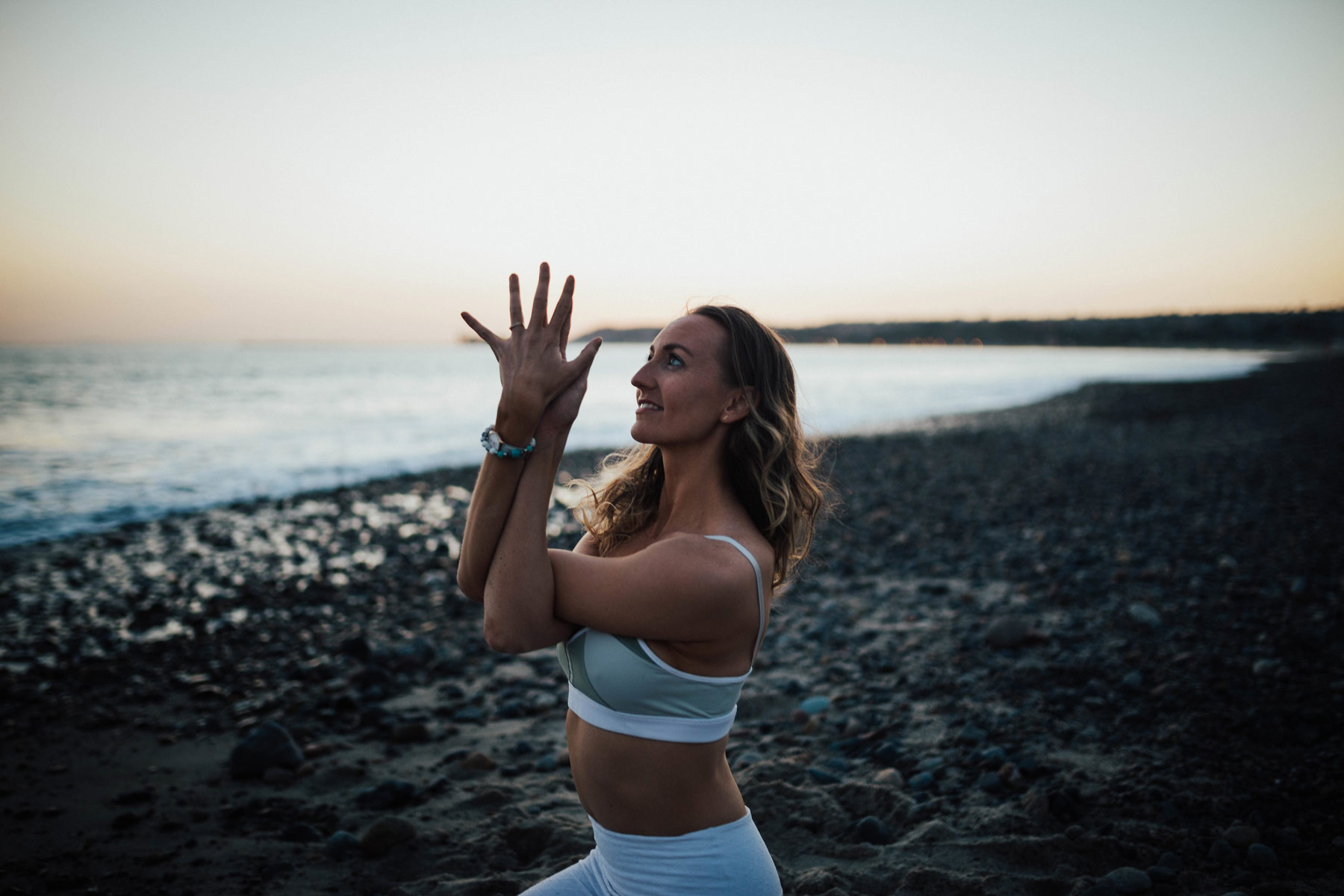
You may often hear your instructor say “soften your gaze” or “use your drishti” during yoga.
But what does that really mean and what importance does this yoga term carry in your yoga practice?
Drishti means “focused gaze” in Sanskrit and is used for concentration and intention. One of the most popular instructors of Ashtanga yoga, Sri K. Pattabhi Jois, introduced Drishti to many practitioners but it has always been a core concept of traditional yogic practices.
The Sanskrit word Drishti is connected to the fifth and sixth limbs of yoga—pratyahara (sense withdrawal) and Dharana (concentration). This is most closely related to the third eye or Ajna chakra.
It’s kinda like that saying, “energy flows where your attention goes.”
Just like your body will naturally move its attention to the part of the body you are focusing on, the same goes for energy.
Think about it.
If your awareness is focused on how you look in the mirror or what other people are doing in yoga, your entire experience will be focused outwardly, on others and what they are thinking or doing.
If you pay attention to the subtle energies, though, you will bring your focus inward. You will automatically focus on your body’s alignment and bring yourself to balance.
To put it into simple matters, imagine when you are practicing downward-facing dog. Your spine is straight, your hips are in the air and your gaze is facing down at the floor to keep the alignment in your neck and spine. If you were looking upwards, this would create a strain in your neck and a curve in your spine.
Similarly, if you are sitting in a forward fold, your gaze will be at your toes…
…not all around the room.
Drishti is used in all the yoga poses and especially during ashtanga vinyasa or vinyasa flow. Combined with other practices like pranayama and meditation, Drishti can support your asana practice and help you stay in the posture and feel more steady.
Once you get more comfortable with using Drishti in your yoga practice, you can even close your eyes and focus on different parts of the body. When we focus our prana inwards, we are focusing on what truly matters.

How Can I Practice Drishti?
There are many different ways to practice Drishti and it all depends on your own personal preference and practice. There are 9 Drishtis that are practiced in traditional Ashtanga yoga and are the most commonly practiced Drishtis in yoga today.
The 9 Drishtis
- Tip of the nose (Nasagram Drishti)
- Between the eyebrows (Ajna chakra or bhrumadhya Drishti)
- At the navel (Nabhi or Manipura chakra Drishti)
- The hand (Hastagram Drishti)
- The toes (Padayoragram Drishti)
- Far to the right (Parshva Drishti)
- Far to the left (Parshva Drishti)
- The thumbs (Angushthamadhyam drishti)
- Upwards toward the sky (Urdhva or antara Drishti)
The most commonly used points to gaze upon or focus on with Drishti are the tip of the nose, between the eyebrows, and the thumb. A great posture to use your Drishti (gaze or focal point) is during balancing postures, like Standing Half Bound Lotus or Ardha Baddha Padmottanasana.
Or you can even practice Drishti in Vriksasana (tree pose)!
When your Drishti is focused on the tip of your nose or between your eyebrows (Ajna chakra), your eyes are half-open and the noise around you is blurred so you can truly focus on that point.
Other parts to focus Drishti are on the navel (nabhi chakra), hand, toes, far to the right, far to the left, your thumbs and to the sky.
This great teaching can be used outside of your yoga practice and be brought into your daily life.
How?
Because even as your practice becomes difficult, causing discomfort or suffering, you are maintaining your directed focus throughout it all. You are choosing to be conscious and aware, even it’d be so easy to step out of consciousness.
And when you bring that to daily life and the swarm of our noisy modern day culture, it helps you maintain consciousness there too.
Drishti allows you to see through judgments and illusions created by your mind and your thoughts. It has a beautiful way of bringing consciousness to every moment and allowing you to experience oneness with the world around you.
Some important things to know in a Drishti meditation are to never force your gaze, that you should always use a soft gaze so you do not strain your eyes.
If you want to start practicing Drishti now, you can use a candle or stare at mandala while sitting in easy pose. This will prepare you for more challenging poses and be calming and meditative for your mind.
In Bhakti yoga, Drishti is used to as a loving gaze to focus upon an image or word that represents God. It is a little bit more abstract but is still within the same concept of turning your attention inwards.
Once you master this concept, you can use Drishti to ease you through any situation.
From the famous yoga text called the Bhagavad Gita:
”The yogi focuses his/her visual energy between the two eyebrows, with equal time in the inhale and in the exhale that go through the nose, master of his/her sensitive, mental and intellectual faculties, the Wise (noble-minded) reaching towards liberation, his/her ultimate end, is separated from desire, from fear and from anger; he is freed forever.”
Experience 3 Training Videos from Inside My 200-Hour Online YTT

YOU MIGHT ALSO LIKE
- What is Kriya Yoga? The Philosophy and Practice
- Uddiyana Bandha: Tapping Into Your Deep Core
- 4 Reasons Hasta Bandha Is Essential To Your Yoga Practice
- Vitarka Mudra: What It Is and How Do You Use It?
- Shakti Mudra: What It Is and How Do You Do It?
- Garuda Mudra: What It Is and How Do You Use It?
- Kali Mudra: What It Is and How Do You Do It?
- Shunya Mudra: What It Is and How Do You Do It?
- Varuna Mudra: What It Is and How Do You Use It?
- Vayu Mudra: What It Is and How Do You Use It?
- Samana Vayu: The Energy of Balance & How to Access It
- Apana Vayu: The Energy of Release & Surrender
- Udana Vayu: The Ascending Wind
- Prana Vayu: The Breath of Vitality
- Vyana Vayu: The Energetic Secret to Flow
Learn how to do 11 of the most popular yoga poses correctly. Free video + PDF download.










